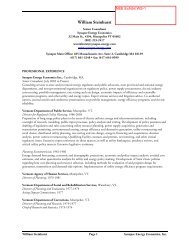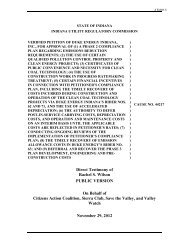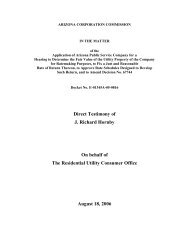Best Practices in Energy Efficiency Program Screening - Synapse ...
Best Practices in Energy Efficiency Program Screening - Synapse ...
Best Practices in Energy Efficiency Program Screening - Synapse ...
Create successful ePaper yourself
Turn your PDF publications into a flip-book with our unique Google optimized e-Paper software.
Figure 4.3. Efficient Frontier of Feasibility Space<br />
Source: NWPCC 2005, p.6-13.<br />
The NWPCC’s Power Plans have historically found that energy efficiency is the most<br />
valuable resource for the region <strong>in</strong> its risk-constra<strong>in</strong>ed, least-cost plann<strong>in</strong>g. The NWPCC<br />
states this po<strong>in</strong>t as follows:<br />
The Council’s power plan addresses the risks these uncerta<strong>in</strong>ties pose for the<br />
region’s electricity future and seeks an electrical resource strategy that m<strong>in</strong>imizes<br />
the expected cost of, and risks to, the regional power system over the next 20<br />
years. Across multiple scenarios considered <strong>in</strong> the development of the plan, one<br />
conclusion was constant: the most cost-effective and least risky resource for the<br />
region is improved efficiency of electricity use … In each of its power plans, the<br />
Council has found substantial amounts of conservation to be cheaper and more<br />
susta<strong>in</strong>able than most other types of generation. In this Sixth Power Plan,<br />
because of the higher costs of alternative generation sources, rapidly develop<strong>in</strong>g<br />
technology, and heightened concerns about global climate change, conservation<br />
holds an even larger potential for the region … The plan f<strong>in</strong>ds enough<br />
conservation to be available and cost-effective to meet 85 percent of the region’s<br />
load growth for the next 20 years. (NWPCC 2010, page 3)<br />
Other Options to Account for Risk Benefits<br />
Options for account<strong>in</strong>g for risk benefits when us<strong>in</strong>g avoided costs for screen<strong>in</strong>g <strong>in</strong>clude:<br />
us<strong>in</strong>g a cost adjustment factor, an additional risk hedge value, adjust<strong>in</strong>g the discount<br />
rates, and apply<strong>in</strong>g a qualitative approach.<br />
Some states account for this benefit of energy efficiency directly <strong>in</strong> their screen<strong>in</strong>g<br />
criteria. For example, Vermont applies a 10 percent cost adjustment factor to its energy<br />
efficiency program screen<strong>in</strong>g to account for the risk benefits. In this process, costs of<br />
efficiency measures are decreased by 10 percent.<br />
| 48 <strong>Best</strong> <strong>Practices</strong> <strong>in</strong> <strong>Energy</strong> <strong>Efficiency</strong> <strong>Program</strong> Screen<strong>in</strong>g | www.nhpci.org







